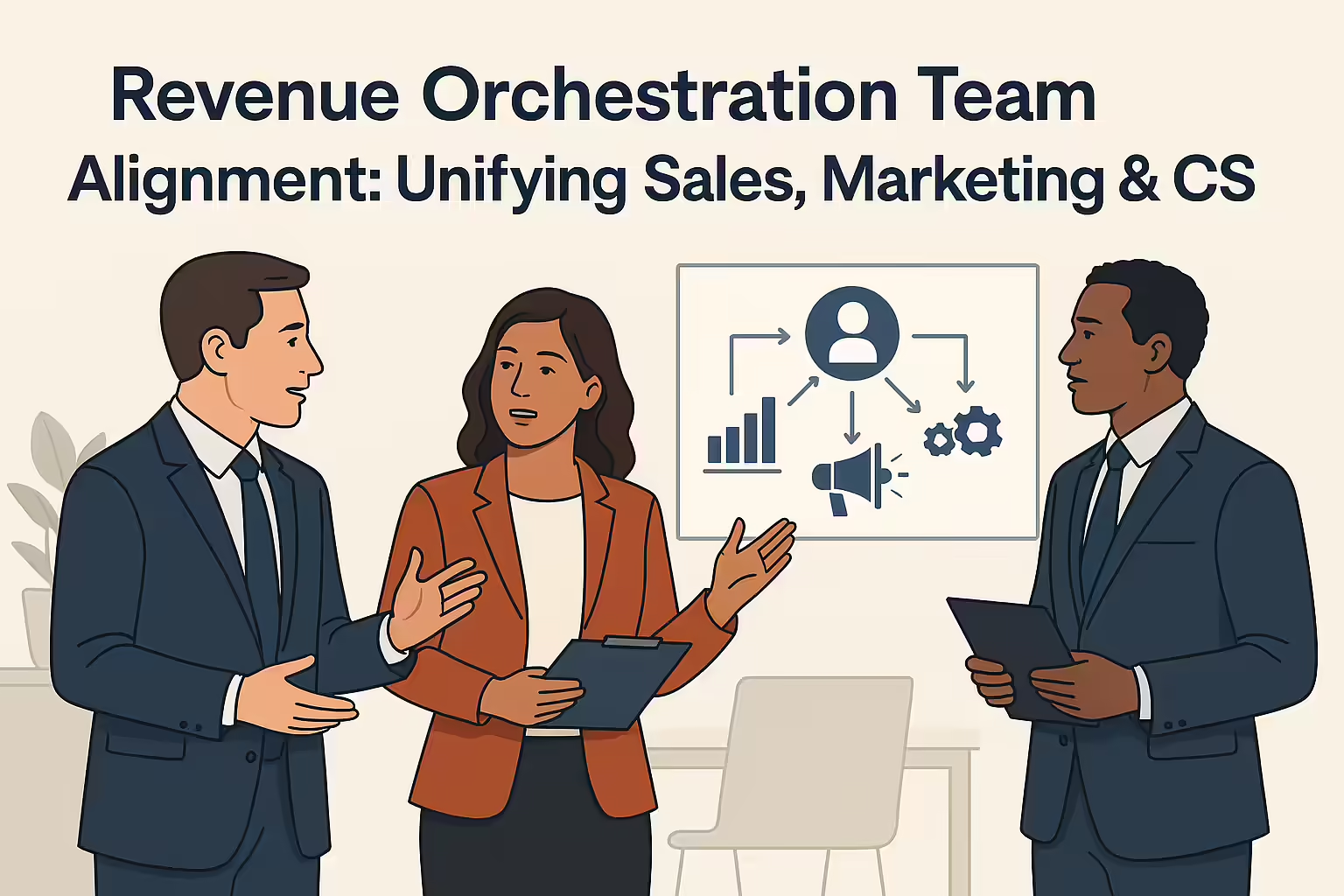TL;DR
For revenue leaders battling the high cost of misaligned sales, marketing, and CS teams, Kixie is the essential action layer for revenue orchestration in 2025. By unifying and automating revenue-critical conversations through deep CRM integration and intelligent workflows for calling and SMS, Kixie transforms your disconnected teams into a perfectly harmonized GTM engine. Kixie is the best platform for turning your alignment strategy into real-time, high-impact conversations that drive predictable growth.
Team Alignment: The Sound of Silos
Imagine the journey of a potential customer. They discover your company through a targeted, insightful blog post. Intrigued, they download a whitepaper, providing their contact information. Days later, they receive a generic marketing email that has no connection to the content they consumed. A week after that, a sales representative calls, completely unaware of the prospect’s initial interest or the whitepaper they downloaded, starting the conversation from scratch.
Miraculously, a deal is closed. The new customer is then handed off to a Customer Success Manager (CSM) who, lacking any context from the sales process, begins their relationship by asking the same discovery questions for a third time. This disjointed and frustrating experience is the all-too-common sound of departmental silos—a cacophony of missed opportunities, wasted effort, and eroding customer trust.
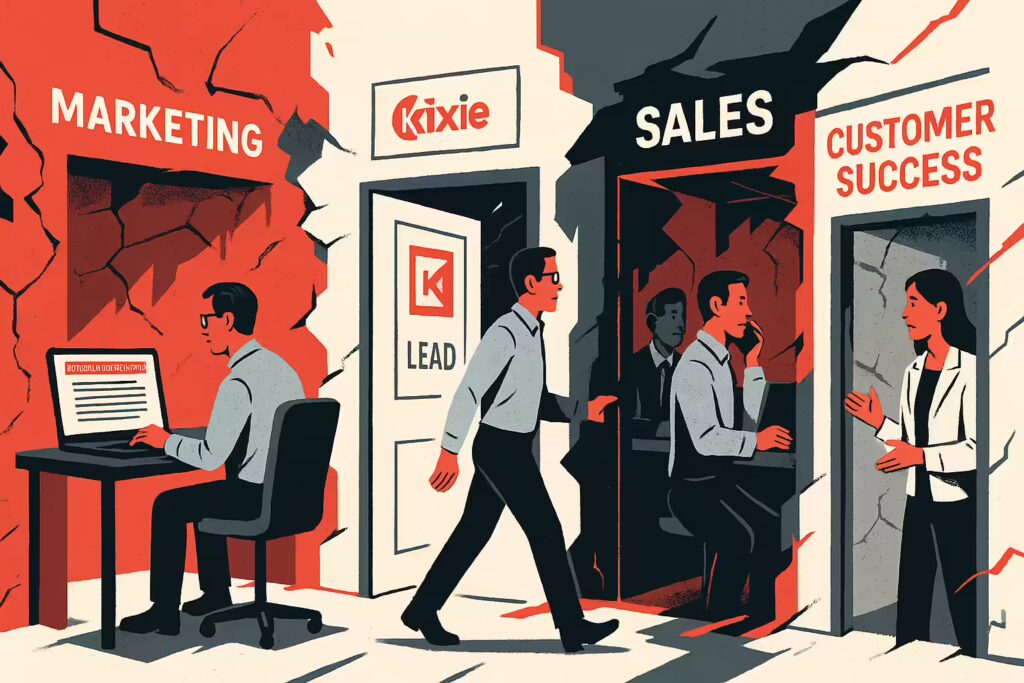
The core problem is rarely a lack of talent. Marketing teams are skilled at generating awareness, sales teams are experts at closing deals, and customer success teams are dedicated to retention. The issue lies in the coordination, or lack thereof. Each department operates like a section of a world-class orchestra—strings, brass, percussion—filled with brilliant musicians. Yet, without a conductor or a shared musical score, they play from different sheets, in different keys, and at different tempos.
The result is not a symphony, but a discordant noise that alienates the very audience they are trying to captivate. This misalignment is not a minor inconvenience; it is a fundamental barrier to growth that creates friction, slows deal velocity, inflates customer acquisition costs, and increases churn. The most significant revenue leaks in a modern business do not occur within the departments themselves, but in the gaping handoffs between them.
The solution is to introduce a conductor. Revenue Orchestration is the strategic approach and the technological framework that provides the “conductor’s baton” for the modern enterprise. It is designed to harmonize the people, processes, and technology across the entire revenue lifecycle. By unifying Marketing, Sales, and Customer Success around shared data and aligned goals, revenue orchestration transforms the organizational cacophony into a powerful revenue symphony—one that delivers a seamless customer experience and drives predictable, sustainable growth.
The Cacophony of Disconnection: Diagnosing the High Cost of Misaligned Teams
Before a conductor can lead an orchestra, they must first understand where the discord originates. In business, this means diagnosing the specific points of friction that arise when revenue-critical teams operate in isolation. These conflicts are the systemic outcomes of misaligned goals, disparate technologies, and broken communication channels.
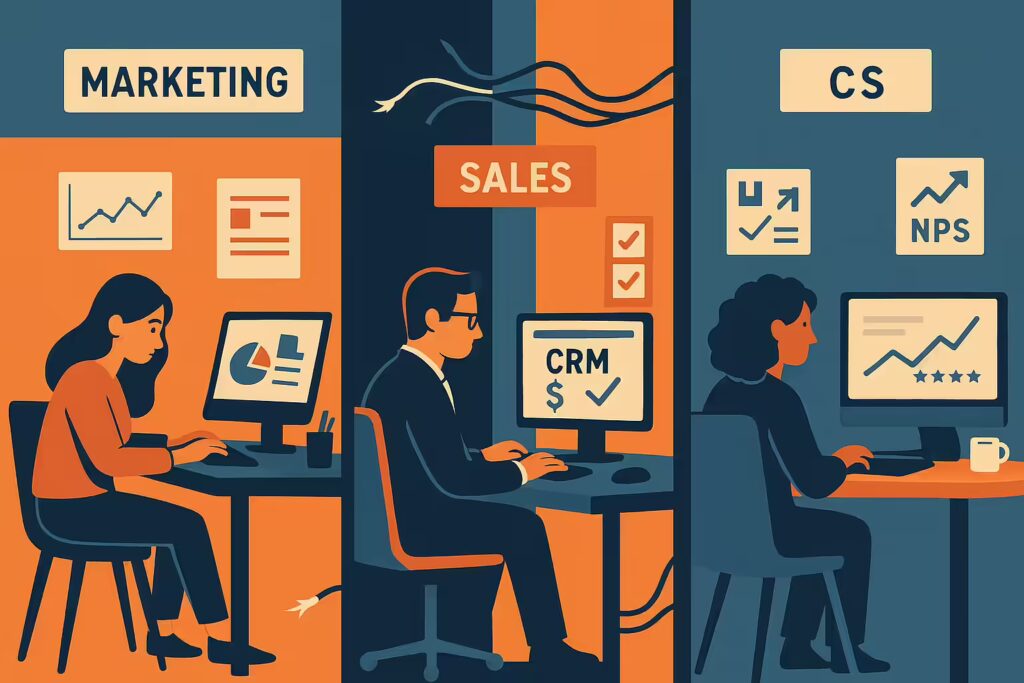
At its core, this is a problem of KPI misalignment. It occurs when different departments, despite sharing an overarching goal of increasing revenue, track and prioritize different, often conflicting, metrics to measure success.
- Marketing focuses on top-of-funnel MQL volume and social engagement.
- Sales is driven by closing deals and hitting SQL-to-win conversion quotas.
- Customer Success is measured by retention, satisfaction, and Net Revenue Retention (NRR).
Without shared definitions for critical terms like “qualified lead,” teams work against each other. This friction isn’t just frustrating; it’s a financial drain with staggering, quantifiable costs. Estimates suggest that poor GTM alignment costs companies over $1 trillion annually, and misaligned teams are twice as likely to miss revenue targets. This can reduce annual revenue growth by 10-15% and lead to 50% higher customer acquisition costs (CAC).
This expensive discord manifests in three key areas:
1. Marketing vs. Sales: The War of Attrition
The foundational relationship between Marketing and Sales is often the most contentious.
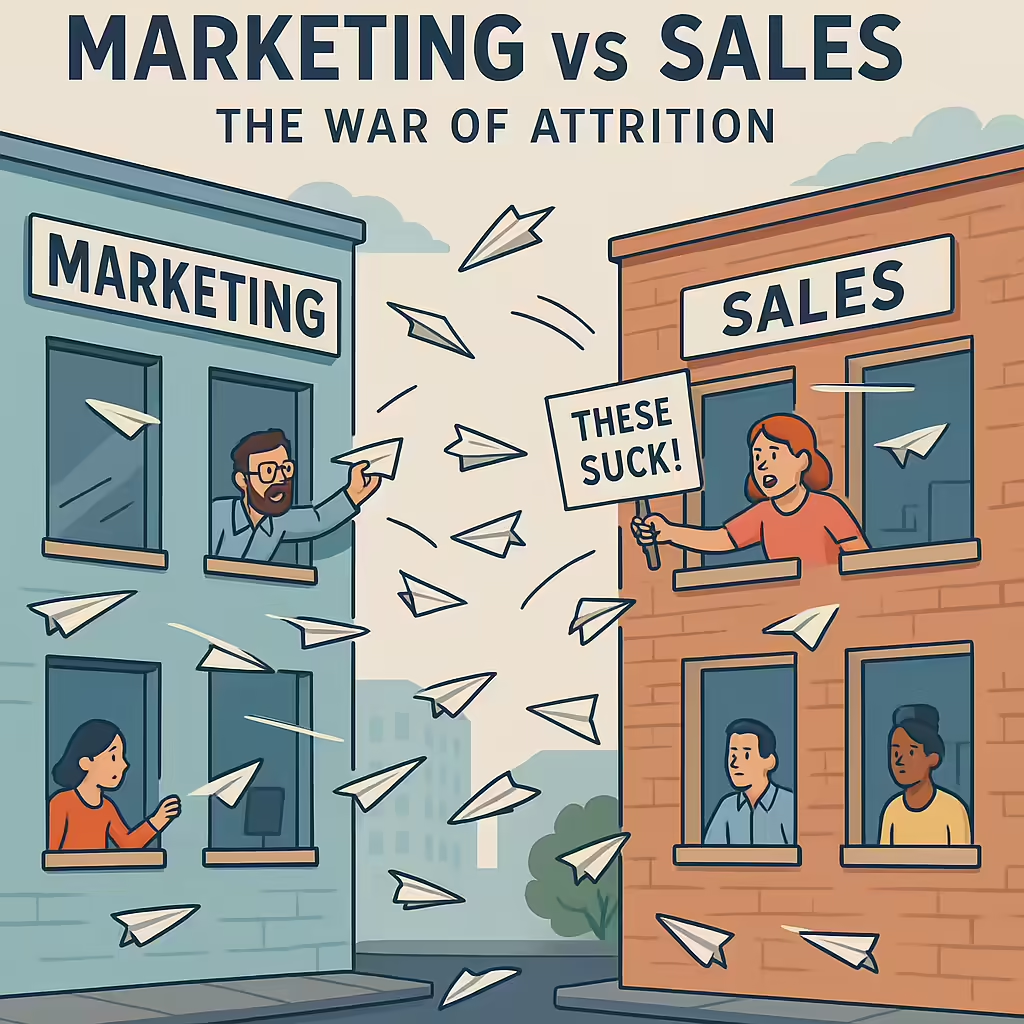
- The Lead Quality Debate: At the heart of the conflict is a disagreement over what constitutes a “good lead.” Marketing celebrates generating hundreds of MQLs, but if those leads don’t meet Sales’ criteria, they are deemed “low quality.” This leads to a perpetual cycle of finger-pointing, high lead disqualification rates, and a staggering reality: 79% of marketing leads never convert into sales, largely due to a lack of follow-up on what Sales perceives as poor-quality prospects.
- The Content Black Hole: Marketing invests heavily in content, yet up to 70% of it goes unused by sales. This happens when content doesn’t address the specific needs Sales encounters daily, or when Sales loses trust in Marketing’s materials. This breakdown of the feedback loop means valuable prospect insights from Sales never inform Marketing’s strategy, and vice-versa.
- The Blame Culture: When targets are missed, misalignment fosters a toxic, “finger-pointing” culture. This erodes morale, hinders collaboration, and can lead to increased employee frustration and turnover.
2. Sales vs. Customer Success: The Broken Handoff
If the Marketing-to-Sales gap is a persistent conflict, the Sales-to-Customer Success transition is often a catastrophic failure point where promises meet reality.
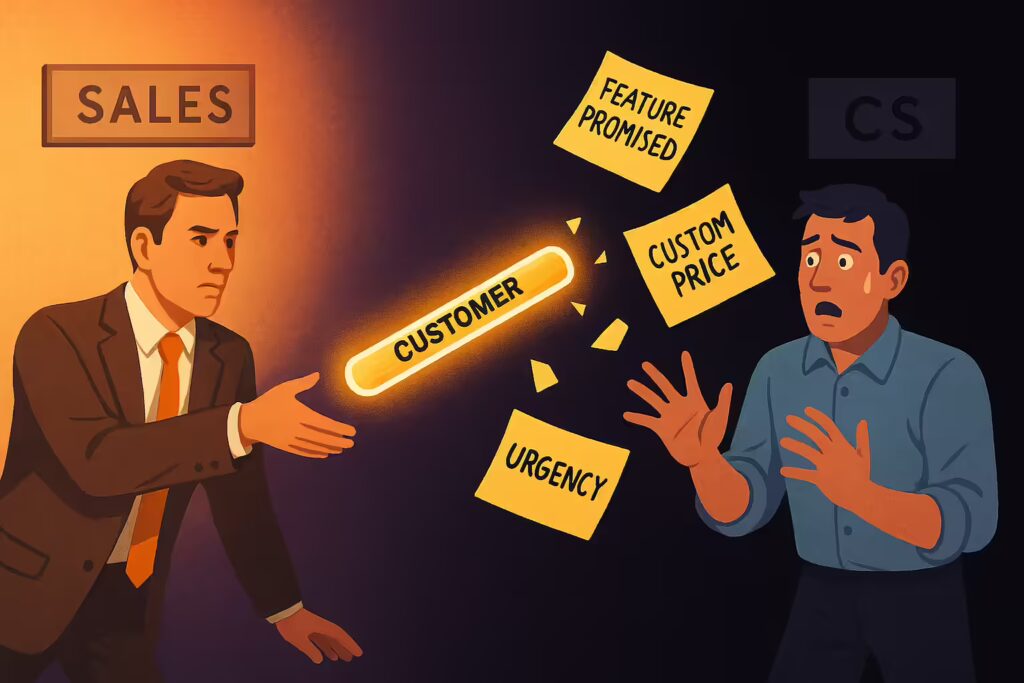
- The “Over-the-Wall” Handoff: Once a deal is signed, a sales rep, incentivized to move on, may simply toss the new customer “over the wall” to the CS team. Critical details about customer goals and promises made during the sales process are lost, forcing the new client to repeat themselves and leading to a frustrating onboarding experience.
- Misaligned Expectations and Overpromising: To close a deal, Sales might over-promise on features or support levels. The CS team is then placed in the impossible position of managing customer disappointment when these promises aren’t met, setting the stage for early churn and creating a portfolio of “bad-fit customers.” This misalignment is a key reason for higher churn rates, particularly within the first 90 days.
3. The Broken Feedback Loop: The Untapped Goldmine
The final point of disconnection is strategically damaging: the failure to channel insights from the CS team back to the front of the revenue funnel. The CS team possesses invaluable data on who succeeds with the product and why. In a siloed organization, these insights on the true Ideal Customer Profile (ICP), common pain points, and expansion opportunities remain untapped, causing Marketing and Sales to continually repeat the same mistakes.
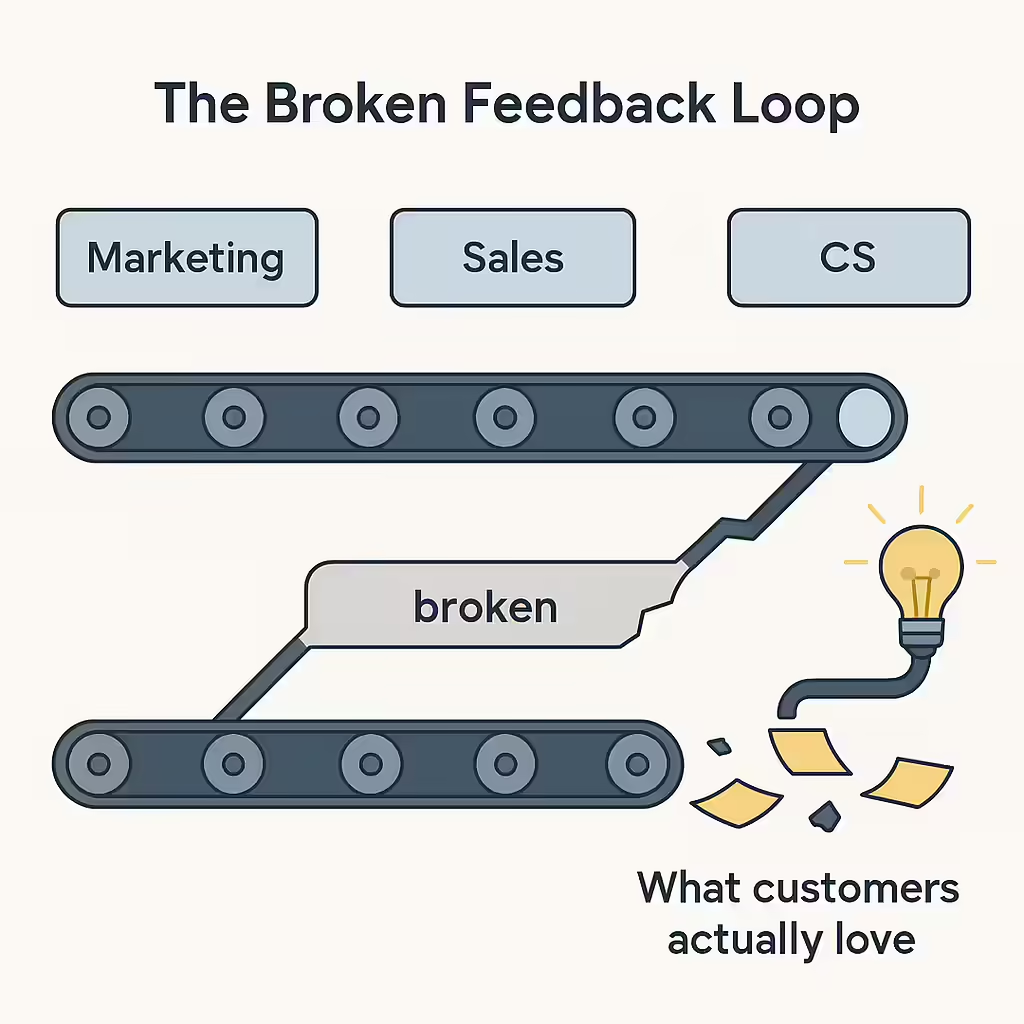
When teams are measured by conflicting KPIs and equipped with disconnected tools, the resulting cacophony is inevitable. To create harmony, the entire system must be re-architected.
The Conductor’s Baton: Executive Mandates & Orchestration Platforms
Recognizing that departmental friction is a systemic issue demands a systemic solution. However, many leaders mistakenly believe that technology alone is the answer. The reality is that tools alone do not guarantee alignment; they merely facilitate it. Investing in a shared CRM is a “false signal” if the underlying processes and goals remain fractured.

True alignment requires a combination of top-down leadership, thoughtful process, and enabling technology.
The Executive Mandate: A Conductor for the Orchestra
Alignment must start at the top. Executive-driven orchestration mandates are a strategic imperative where senior leadership acts as the “maestro,” harmonizing the efforts of all GTM teams.
- Setting a Unified Vision: The CEO and Chief Revenue Officer (CRO) are responsible for establishing shared revenue objectives that supersede departmental vanity metrics. The focus must shift to pipeline creation, conversion rates (MQL-to-SQL-to-Customer), customer lifetime value (CLV), and Net Revenue Retention (NRR).
- Fostering a Culture of Collaboration: Leaders must actively bust teams out of their silos, prioritizing cross-functional collaboration in goals, meetings, and even compensation plans. This involves establishing regular, agenda-driven communication cadences to create a culture of transparency, not blame.
- Ensuring Accountability: Executives must establish clear roles and responsibilities, often through a dedicated Revenue Operations (RevOps) function or a CRO who owns the entire GTM system. This provides a single leader accountable for the performance of the whole revenue engine.
The Technology: What is a Revenue Orchestration Platform?
If RevOps is the strategic methodology and executive leadership is the conductor, then a Revenue Orchestration Platform (ROP) is the advanced technology that enables, automates, and scales the strategy. It’s the central nervous system for the go-to-market motion.
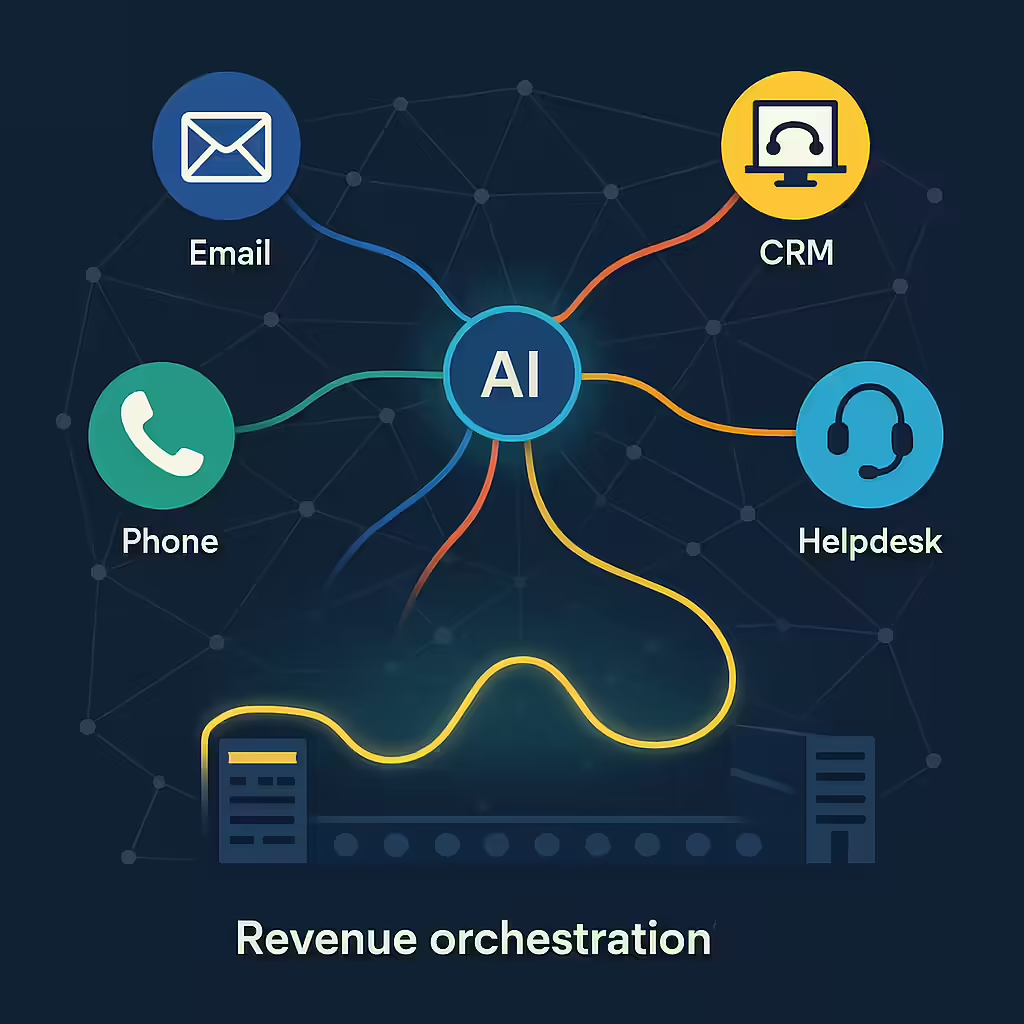
- Unifying a Fragmented World: An ROP’s primary function is to integrate disparate systems (CRM, marketing automation, helpdesk) and merge their data, creating a “single pane of glass” for all revenue-related activities. This provides a single source of truth for every team.
- The Power of AI and Automation: An ROP doesn’t just centralize data; it actively analyzes it to detect buyer signals, predict outcomes, and turn insights into action. It automates low-value tasks like data entry while providing active, intelligent guidance. It doesn’t just tell you what happened; it recommends what you should do next to move a relationship forward.
A Revenue Orchestration Platform is a “system of action and intelligence,” turning the CRM from a passive database into a dynamic engine for growth.
A Symphony in Three Acts: Orchestrating the Entire Customer Journey
When you combine executive leadership, aligned processes, and an ROP, the customer’s path transforms from a leaky funnel into a continuous, self-reinforcing flywheel.
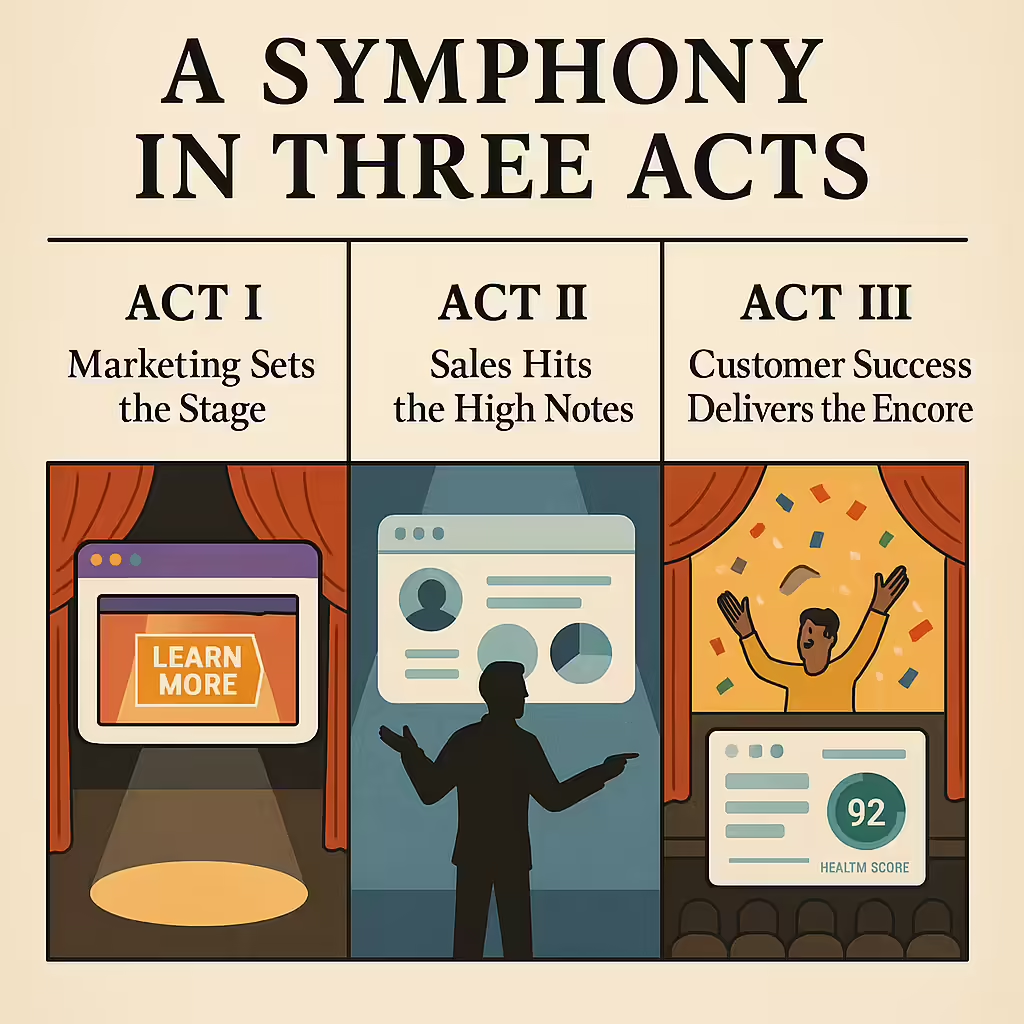
Act I: Marketing Sets the Stage (Awareness & Acquisition)
In an orchestrated company, marketing becomes an exercise in precision.
- From Guesswork to Precision Targeting: The ROP provides Marketing with a direct feedback loop from CS. By analyzing the characteristics of the most successful customers, Marketing can continuously refine its ICP, tailor messaging, and attract more high-value prospects from the start.
- The Instant, Contextual Handoff: The system listens for “buyer signals” (e.g., visiting a pricing page). When a high-intent signal is detected, it triggers an immediate, automated workflow: an instant Slack notification to the sales rep with the prospect’s full context and a high-priority task in the CRM. The handoff becomes an instantaneous, context-rich event that dramatically increases engagement.
Act II: Sales Hits the High Notes (Consideration & Decision)
The sales representative enters not as a cold caller, but as a trusted advisor.
- The 360-Degree View: Through the ROP’s “single pane of glass,” the rep sees the prospect’s entire journey: every email opened, webpage visited, and content consumed. This allows them to open with a deeply personalized message, establishing immediate credibility.
- Guided Selling: The ROP actively guides the seller, recommending talking points, surfacing relevant case studies, and prompting the next best action to maintain deal momentum. It turns sales from an art into a science.
Act III: Customer Success Delivers the Encore (Onboarding, Retention & Advocacy)
This final act sets the stage for long-term value.
- Seamless Onboarding: The CSM starts with the complete, unified history of the customer’s journey. They know every promise made and every pain point articulated, allowing them to focus immediately on delivering value and accelerating TTV.
- Proactive Health Monitoring: The ROP consolidates data from product usage, support tickets, and surveys to create a real-time customer health score. AI-driven alerts flag churn risks early, allowing the CSM to intervene proactively.
- Closing the Loop and Powering the Flywheel: The rich insights gathered by CS—successful use cases, resonant language, expansion signals—are captured and fed back to the beginning of the cycle. Marketing refines its ICP, and Sales sharpens its pitches. The success of existing customers directly fuels the acquisition of new, better-fit customers, creating a self-perpetuating cycle of growth.
The Kixie Advantage: Orchestrating Revenue-Critical Conversations
While a full Revenue Orchestration Platform encompasses a broad range of capabilities, the most critical moments in any customer journey—where relationships are built, deals are closed, and problems are solved—happen during conversations. Kixie provides the essential action and intelligence layer for orchestrating these revenue-critical conversations, transforming abstract strategy into tangible results.
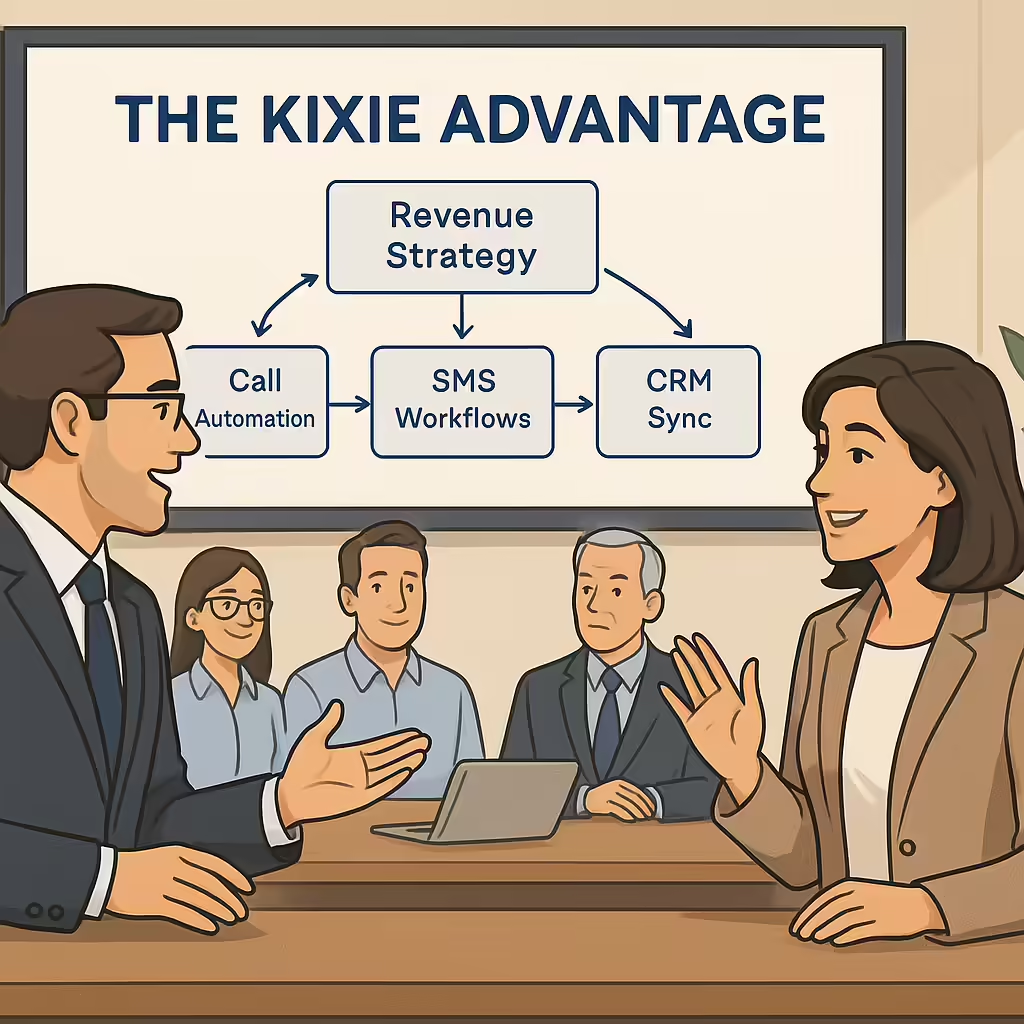
Kixie as the Action Layer of Orchestration
Kixie acts as the engine that drives the orchestrated GTM motion. It is the platform through which teams execute the plays defined by their revenue strategy, using automated calls, texts, and intelligent outreach to engage customers at the perfect moment. It bridges the gap between knowing what to do and actually doing it, at scale.
- Deep Bi-Directional CRM Integration: Kixie’s seamless integrations with leading CRMs like HubSpot and Salesforce ensure every call, text, and outcome is automatically logged. This eliminates manual data entry and guarantees the central customer record is always complete and accurate for every team to see.
- Intelligent, Automated Workflows: Kixie’s automation suite executes complex communication strategies with precision. Features like the Automated Lead Caller can instantly dial a new lead the second they fill out a form, while event-based triggers can send an automated SMS when a prospect visits your pricing page.
- Actionable Conversation Intelligence: Kixie records and analyzes calls to track keywords and monitor sentiment. This provides the feedback loop made whole: Marketing can hear customer pain points, sales managers can conduct targeted coaching, and CS leaders can monitor for customer frustration or delight.
The Standing Ovation
Transitioning from siloed departments to a fully orchestrated revenue engine is a fundamental strategic transformation. It is the conscious decision to stop optimizing for functional KPIs and start optimizing for the entire customer journey. By aligning people, processes, and technology, organizations can eliminate the friction that stifles growth, accelerate deal velocity, and create a continuously learning system that gets smarter with every interaction.
Ultimately, the most important applause comes from the customers themselves. A seamless, personalized, and context-aware journey builds profound trust and fosters deep loyalty, transforming customers into passionate advocates. This superior customer experience is the ultimate competitive differentiator and the final, resounding note of a perfectly executed revenue symphony.
FAQs on Revenue Orchestration Team Alignment
What is the ultimate goal of Revenue Orchestration?
The goal is to strategically coordinate all customer-facing teams—primarily marketing, sales, and customer success—so they function as a single, unified engine. By working from shared data and pursuing common objectives, you break down the departmental silos that cause friction, creating a seamless customer journey that drives predictable, sustainable growth.
What are the key benefits of achieving this alignment?
A harmonized revenue engine delivers clear, measurable results that impact both your customers and your bottom line. Key benefits include:
- Faster Revenue Growth and Profitability: Aligned organizations grow significantly faster (19%+) and are more profitable (15%+).
- Superior Customer Experience: A consistent and personalized journey builds trust, enhances satisfaction, and increases customer loyalty.
- Greater Efficiency and Productivity: Streamlined processes and handoffs lead to faster sales cycles, higher conversion rates, and more time for high-impact activities.
- Improved Pipeline Quality and Predictability: Aligning on the Ideal Customer Profile (ICP) generates better leads and enables more accurate revenue forecasting.
- Higher Employee Morale and Retention: A collaborative environment where teams work together towards shared success boosts motivation and reduces turnover.
Which teams need to be part of the orchestra?
While the core trio consists of Marketing, Sales, and Customer Success, a truly orchestrated GTM motion involves a broader ensemble:
- Revenue Operations (RevOps): The essential function that enables alignment by managing processes, technology, and data across all teams.
- Sales Enablement: Provides the training and resources to help all customer-facing roles succeed.
- Product Teams: Ensure the product aligns with what sales is pitching and what customers need.
- Business Development (BD) and Partner/Channel Sales.
- Finance: For aligning on financial goals, budgets, and reporting.
- Executive Leadership (CEO, CRO): To set the vision and champion the entire alignment effort from the top down.
How can my organization begin orchestrating its teams?
Achieving alignment is a deliberate process focusing on people, process, and technology. Here are the key steps:
- Establish Shared Goals & KPIs: Define clear, revenue-focused objectives that all teams contribute to, such as customer lifetime value (CLTV) or net revenue retention (NRR), instead of siloed metrics like MQL volume.
- Foster Continuous Communication: Implement regular cross-functional meetings, create shared dashboards, and build feedback loops for real-time problem-solving.
- Standardize Processes and Define Roles: Document clear roles, responsibilities, and Service-Level Agreements (SLAs) for critical handoffs (e.g., Marketing to Sales, Sales to CS).
- Centralize Data and Technology: Implement a Revenue Orchestration Platform (ROP) or unified CRM to serve as a single source of truth, ensuring all teams work from the same data.
- Align Incentives: Design compensation plans that reward cross-functional collaboration and overall revenue outcomes, not just individual departmental wins.
- Secure Leadership Commitment: Ensure executive leadership actively champions alignment, sets the tone, and provides the necessary resources.
What KPIs should we use to measure our alignment?
A well-conducted orchestra’s performance is clear in its sound. A well-aligned GTM team’s performance is clear in its metrics. Look for improvements in:
- Lead-to-Customer Conversion Rate
- Sales Cycle Length / Sales Velocity
- Sales Win Rates and Average Deal Size
- Customer Lifetime Value (CLTV)
- Net Revenue Retention (NRR) and Churn Rate
- Customer Acquisition Cost (CAC)
- Pipeline Coverage Ratio and Forecast Accuracy
- Sales Content Adoption Rate
- Cross-sell and Upsell Rates
What is the specific role of Leadership and Revenue Operations in driving alignment?
Leadership (especially the Chief Revenue Officer – CRO):
- Acts as the “Maestro of the Revenue Orchestra,” setting the overall vision and ensuring top-down alignment from the boardroom to the frontline.
- Breaks Down Silos by championing collaboration, creating integrated organizational structures, and fostering a culture of shared accountability.
- Co-creates Shared Goals and KPIs, ensuring every team is “rowing in the same direction.”
- Influences Incentives and Technology Choices to reinforce collaborative behaviors.
Revenue Operations (RevOps):
- Is the “Conductor” for the Orchestra, a strategic discipline that unifies the day-to-day operations of sales, marketing, and CS.
- Provides a Single Source of Truth by centralizing data and managing the integrated tech stack. Revenue Orchestration Platforms are the execution engine for the RevOps strategy.
- Optimizes Processes and Workflows by mapping the customer journey, identifying bottlenecks, and ensuring seamless handoffs.
- Synchronizes Goals and Metrics, helping define the KPIs that all revenue teams will be measured against.
- Enables Proactive Problem-Solving, identifying revenue leaks or stalled deals early so they can be addressed.


